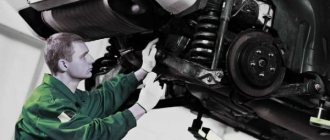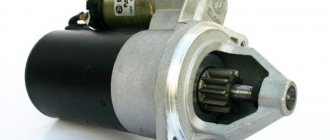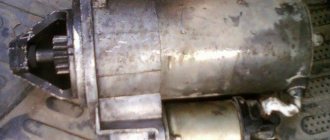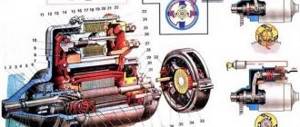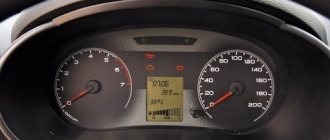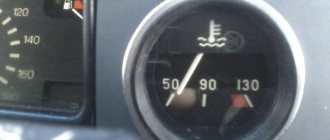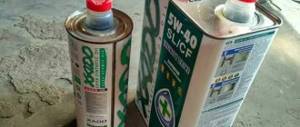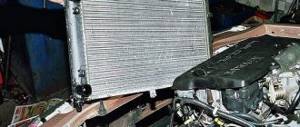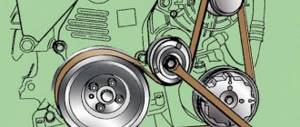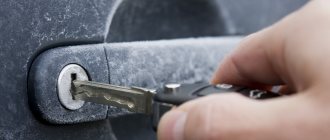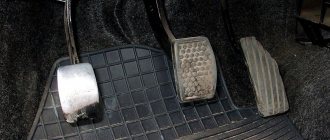August 25, 2014
4 min
…
Many drivers have encountered such an unpleasant situation when the starter does not want to turn the engine and start the car. And it’s not a matter of the battery, because even no attempts are made to move the power unit. There is just a kind of click and nothing else happens. In such a situation, you have to push start the car or come up with other ways to start the engine.
If the starter clicks but does not turn, there are several types of car problems that are worth paying attention to. This problem will have to be solved immediately after it occurs, because further movement is only possible with a working starter. Especially when it comes to large cars, which cannot be started from a pusher.
The starter does not turn: reasons
A car starter is just a regular electric motor that uses a battery as its power source.
Electricity consumption to operate the starter is quite significant, but due to the short time required for the starter to operate (only a couple of seconds), the battery does not have time to discharge.
There are three main reasons why the starter does not turn and refuses to work:
- battery;
- starter;
- car electrician.
The starter relay clicks, but the starter does not turn over.
If you have heard that something wrong is happening under the hood of your car, and judging by the descriptions, it is the retractor that clicks and the starter does not turn, then, first of all, you need to understand the internal structure of the starter.
One of the components of the starter is a traction, or, in other words, retractor relay, made in the form of a small cylinder attached to the base of the starter.
The starter winding, located on the relay, is also divided into retracting and holding, and, in the absence of the necessary voltage on the holding winding, the starter breaks down.
The winding draws in the core, but when it returns to its original position due to a voltage deficiency, characteristic clicks are heard. It is about this situation that drivers say that the starter solenoid relay clicks, but the starter does not turn.
There may be several reasons for this phenomenon:
- Battery. Discharge, or insufficient battery charge, or poor contact between the terminals and wires can lead to this state of affairs. Charge the battery and try starting the car after that.
- Poor engine and body weight. Try using a different ground wire.
- One clear click. Check the engine weight and how the traction relay is attached to the starter housing. Inspect the contacts on the relay, maybe the problem lies there. In addition, the cause of the breakdown may be a malfunction of the starter itself. In this case, it is necessary to disassemble it and then replace it.
The retractor clicks, the starter does not turn
In the case where the problem lies in the starter itself, there are several reasons why this happens.
- The power wire connecting the starter winding and the traction relay may burn out and become unusable.
- The armature winding has broken or short-circuited.
- Problems with the fork in the Bendix drive.
Another common type of breakdown is faulty starter bushings. They are made in the form of bearings and are located in the front and rear of the starter. Bearings ensure smooth rotation of the starter shaft.
When the bearings wear out, the relay may click, but the starter itself does not spin and the engine does not start. This occurs due to the shaft being displaced from its axis. Associated problems will be, in this case, short-circuiting of the windings and melting of the power wires.
There are frequent cases of electrical circuit shorting and engine fire. Do not try to start the car by holding the key in the start position for a long time. It is better to make several short movements with the wrench, and there is a chance that the shaft will fall back into place.
If such problems, which are already quite serious in nature, are discovered, you should seek the help of a specialist for large-scale and labor-intensive repairs.
Car won't start after replacing starter
Guys, I'm upset. The car refuses to start. They replaced the armature on the starter and installed it, but the car won’t start. The starter turns, but it's just not enough to start. The car stood in the garage for 2 days, in the garage at above-zero temperatures, i.e. not frozen. The candles were flooded, then the burn put them back in place, but still it doesn’t want to. What could it be? Maybe some sensor was touched when I removed the starter, I can’t imagine. And also, when you turn on the ignition, something starts to hum (like in a transformer box).
Let me remind you that I tried to start it in the cold and burned the anchor on the starter
rules
For those asking a question:
Here you can count on help leading you to solving the problem on your own, but for ready-made solutions, turn to specialists at your place of residence.
In the topic title, indicate the name of the car model and year of manufacture, in the subtitle - the essence of the problem. Before opening a topic, read the Forum Rules. Colleagues:
You should not give out ready-made solutions, even if you know them, especially if this is an attempt to guess.
Profile Group: Active Messages: 15 User No.: 11810 On the forum since: 09/27/2008
Has warnings: (0%)
Hello. Here is how it was. The starter failed, the car was started using a pushrod. They replaced the starter themselves with someone else's spare one, and gave ours to a mechanic to sort it out. After the replacement, the car stopped starting a day later; you turn the key - silence. The starter, which is foreign, is definitely working. The service electrician installed an additional relay from the battery to the starter, and the car started to start. It's time to replace someone else's starter with your own, already working one. They changed it and everything happened again. The car started up four times and that was it. And additional the relay didn't help. The battery is new, in good condition, charged. The terminals are cleaned, plus and ground are screwed securely, as well as the power wires. The red power wire from the battery to the starter was checked. The contacts in the retractor were also checked and cleaned - nothing. The ignition switch, wires, fuses and relays in the cabin - everything was checked by an electrician back then, that’s not the point. I just don’t know what to think - we’ve looked at all the options.
Funny. When we pulled the black ground wire to the starter, at first the alarm beeped faintly, then suddenly it stopped working, as did the door block. I don’t know how the alarm works for us, it was installed under the previous owner, maybe it’s buggy and blocks the starter? She blinked strangely and the sound disappeared before. What could it be.
The solenoid relay does not click, the starter does not turn
The main element involved in the operation of the starter is the relay. Accordingly, if such a phenomenon occurs when the solenoid relay does not click and the starter does not turn, the reasons must be sought in the relay. It is this that is the source of the clicking sounds so clearly heard when starting the engine.
This is possible, among other things, if the starter brushes are extremely worn. Then electricity is not supplied at the required voltage to the solenoid relay. When you turn the ignition key, you will not hear any reaction from the starter, sounds of the electric motor or clicks of the traction relay.
To fix this problem, you will have to disassemble the starter, inspect the brushes and, if necessary, replace them. Inside the starter, the windings are also subject to wear. A characteristic symptom is a burning smell when starting the engine.
It is necessary to dismantle the starter and look at the condition of the windings. If their color is dark and the varnish has faded, this is a sure sign of the need for urgent replacement. This can also happen during a long ignition if there is a problem starting the engine.
Why doesn't the starter work?
It often happens that when you turn the key in the ignition switch, instead of the usual rattling of the starter, there is silence.
It is especially unpleasant when at this moment you urgently need to go. Why might the starter fail? A starter is an electric motor that starts an internal combustion engine through a mechanical drive. Accordingly, all its malfunctions can be divided into electrical and mechanical. According to tradition, we will analyze them all point by point and see what can be done in a given situation.
The starter is silent
When you turn the ignition key to the engine start position, nothing happens at all. Not a single sound comes from under the hood, the lights on the instrument panel do not go out. Such signs most often indicate that there is no electrical connection between the ignition switch and the starter at all. What does it mean?
When you turn the key in the ignition switch, its internal contact group supplies voltage to the starter solenoid relay, it is activated and connects its electric motor. An unloading electromechanical relay is often also installed in this chain. If, when you try to start the car, the starter is silent, not even making a click, it means:
– The contact group of the ignition switch is faulty. The required contacts do not close or no current passes through them. The reasons for the malfunction of the contact group are here. In most cases, it will simply have to be replaced with a new one.
– The starter relay is faulty. There are many reasons why a relay may not pass current. All of them, as well as the search method, are in the article on how to check a relay in a car.
– Wires are broken or disconnected. In the chain “ignition switch contact group – relay in the mounting block – starter solenoid relay” there may be no contact due to a broken or simply disconnected wire. For example, the wire from the solenoid relay itself may fly off or the connector in the mounting block may oxidize. In this case, you need to check the entire chain with a test lamp or multimeter.
– The starter solenoid relay itself may also be faulty. Then it will have to be replaced.
The solenoid relay clicks, but the starter does not turn
If, when you turn the key to start, a distinct click is heard from under the hood, but there is no rattling of the starter, then its retractor relay is working properly, but for some reason the electric motor does not start. There may be the following reasons for this:
– Solenoid relay is faulty. There are contacts inside the relay that close when it is activated. This principle completely repeats the operation of a conventional 4-pin relay, only it has a slightly different design. The contacts of the solenoid relay can burn and stop passing current. In this case, the retractor needs to be changed. Another option is to try to disassemble the old one and clean the contacts, but such a “repair” will not help for long.
– The battery is low. Due to low voltage in the on-board network, the starter motor simply does not have enough current to start. It is very simple to determine this reason for the “failure” of the starter - when you try to start, the lamps on the instrument panel go out or become very dim. However, similar symptoms may also refer to another type of malfunction!
– Starter wedge. This is the malfunction. The symptoms are the same - the retractor clicks, the starter does not turn, the lights go out, but the battery is well charged! This happens due to very difficult rotation of the starter armature. This usually happens on old starters without a planetary gearbox. Their anchor is installed in bushings. Over time, the bushings break and the anchor begins to jam. When you try to turn on such a starter, it receives a very large current, which extinguishes the lamps on the panel, but is not able to turn the jammed armature. In such cases, you need to make sure that the battery is charged, remove the starter and: 1) Replace it with a new one with a planetary gearbox; 2) Replace old broken bushings with new ones.
– Breakage or burning of the starter motor winding. In this case, it is easier to replace the starter with a new one. However, there may be other, less complex faults within the starter. For example, worn brushes that can be replaced quite easily. Therefore, before deciding to replace the starter assembly, you need to make sure of the seriousness of the damage, especially since the starter is not cheap.
The solenoid relay is cracking
When you try to start the engine, the starter does not work, but a loud cracking noise is heard from under the hood. This is the solenoid relay cracking. The cracking sound is caused by the retractor turning on and off, as if you were quickly turning the starter on and off with the key in the ignition.
A pull-in relay differs from a regular relay not only in size, but also in the presence of a holding winding, which is not present in a conventional relay. This winding keeps the relay armature on while the starter motor is running. If the winding is faulty, then when this engine (directly the starter) is turned on, the relay armature returns and immediately moves again under the action of the retractor winding connected through the ignition switch. This cycle will be repeated exactly as long as you keep the key in the lock in the “Starter” position. Since the retractor relay armature is not able to lock into the desired position, the starter motor contacts do not close and it does not work. In the process of rapidly moving back and forth, the retractor relay armature creates a well-known crackling sound. In such cases, the solenoid relay must also be replaced with a working one.
How to keep the starter in working condition
In order not to bring the starter to condition when the above-described situations may occur in which it is impossible to start the car, it is necessary to follow a number of simple rules for its operation.
We turn the starter for no more than five to ten seconds, after which you need to take a mandatory pause for a couple of minutes. If you ignore this advice, you run the risk of instantly draining the battery and burning out a functioning starter if you overzealously try to start the engine.
Then nothing will save you from the need to buy a new starter, since if the windings burn out, their repair is unlikely to be cheaper. Moreover, it is often impossible to properly repair the starter in this case.
Don't forget, first of all, pay attention to the battery, maybe just charging it is enough. Leave the car for a couple of hours, and perhaps, after charging the battery, the problems will be solved and you can safely start the car and drive it according to your needs.
Check the contacts and clean the areas where the cables touch. Place special emphasis on the negative ground wire going to the car body.
Be that as it may, diagnosing the starter and repairing its individual elements will cost the car enthusiast much less than replacing it with a new, very expensive unit when purchased.
Pay attention to suspicious sounds when starting the engine, and this may help save you a considerable amount of money.
Starter malfunctions and methods for eliminating them Lada Largus
Tool:
- Open-end wrench 10 mm
- Open-end wrench 13 mm
- Multitester
- Driver for socket attachment
- Extension for the end attachment on the wrench
- 8mm wrench attachment
- 10mm wrench attachment
- 13mm wrench attachment
- Medium flat screwdriver
- Stationary charger
- Pliers
Parts and consumables:
- Vaseline technical VTV-1 in aerosol packaging
- Sanding paper with a grain size of no more than P220 or felt with abrasive paste PMA-2
- Starting system contact connections
- Egnition lock
- Starter traction relay
- Flywheel
- Starter drive
Notes:
To confirm a malfunction of the engine starting system, the following deviations in the operation of other mechanisms must appear, which can be seen by performing a series of actions described below.
1. When diagnosing the cause of a problem with normal engine starting, open the car door and watch how the brightness of the interior lighting bulbs changes.
Note:
The brightness of the lighting lamp depends on its supply voltage. During normal starter operation, the brightness of the interior lighting decreases slightly.
If the brightness of the lighting does not change, then the cause of the problem is usually an open circuit in the starting system control circuit.
If the lighting almost or completely goes out, then the cause of the problem is most likely a short circuit or breakdown to ground in the starter field windings or a faulty battery.
2. Do not knock on the starter as this may damage the starter parts.
Note:
In the past, it was not uncommon to see a technician banging on the starter to try to figure out why it wasn't working. Frequently, shock loads caused alignment or displacement of the current collector brushes, rotor, and bearing shells. In many cases, after a blow to the starter, its performance was restored, even if only for a short time.
But the design of most modern starters uses permanent magnets, which are fragile and can break if the starter is hit. A broken magnet disintegrates into several weak magnets. In some of the first designs of permanent magnet starters, the magnets were glued to the stator housing. With a strong blow to the starter, these magnets shattered into pieces, which, when they hit the rotor or in the bearing sockets, rendered the starter completely unusable.
Causes and methods of troubleshooting the starting system.
The starter does not turn on
1. The battery is faulty - check the battery.
2. Oxidation of the battery terminals and wire ends - strip, secure and lubricate the wire ends and terminals with petroleum jelly as described in this article.
3. Broken contacts in the connections, broken wires in the power supply and starter control circuits - check, clean, tighten or replace the contact connections in the power supply and starter control circuits.
4. Malfunction of the ignition switch (lock) - replace the contact group of the ignition switch (lock).
5. The traction relay is faulty - replace the traction relay.
6. The starter is faulty - repair the starter by removing it as described here.
The traction relay turns on, but the starter armature does not rotate or rotates too slowly.
1. The battery is very discharged - charge or replace the battery.
2. Oxidation of the battery terminals and wire ends - clean, secure and lubricate the wire ends and terminals with technical petroleum jelly.
3. Weak tightening of the nuts securing the wire lugs to the traction relay terminals - tighten the nuts using wrenches.
4. The starter is faulty - repair the starter by removing it as described here.
The traction relay turns on and off immediately (frequently repeating knocking)
1. The battery is very discharged - charge it with a stationary charger or replace the battery.
2. Increased resistance in the starter power supply circuit - strip and secure the wire ends. Replace faulty wires.
3. The ignition switch (lock) is faulty - replace the contact group of the ignition switch (lock).
4. The traction relay is faulty - replace the traction relay.
The starter turns on, but the crankshaft does not rotate
The starter is faulty - repair the starter by removing it as described here.
The starter turns on, but the gear does not engage
Gouges on drive gear teeth or flywheel rim - remove nicks or replace flywheel or starter drive.
The starter does not turn off after starting the engine
1. The key is stuck in the ignition switch (lock) in position “D” - repair or replace the mechanical part of the ignition switch (lock).
2. Short circuit of the ignition switch (lock) contacts - replace the ignition switch (lock).
3. The starter is faulty - repair the starter by removing it as described here.
Increased noise level when rotating the starter armature
1. The starter is loose - tighten the starter bolts.
2. The teeth of the starter drive gear or the toothed rim of the engine flywheel are damaged - replace or repair the starter, replace the engine flywheel.
3. The starter is faulty - repair the starter by removing it as described here.
The article is missing:
- Photo of the instrument
- Photos of parts and consumables
Source:
